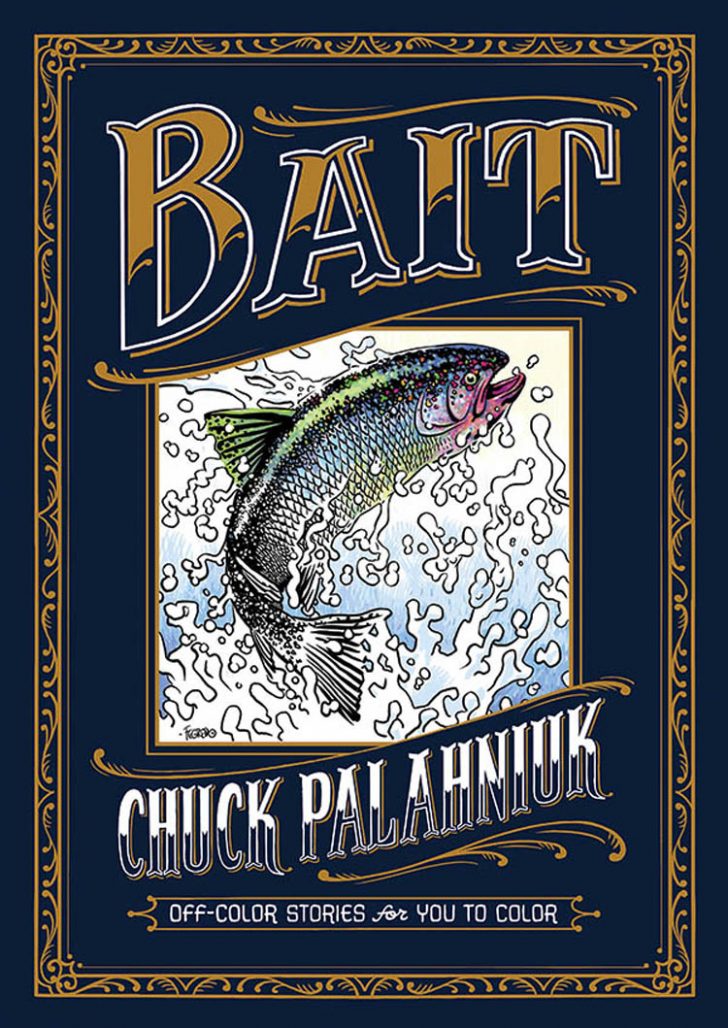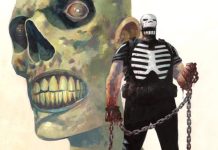The mind that changed our perspectives on the childish idea of an imaginary friend is taking the innocent notion of a coloring book and warping it into a complex emotional symphony dealing with ideas such as legacy, fame, and survival. Author, Chuck Palahniuk has dubed this collection of short stories, Bait: Off-Color Stories for you to Color. In this unique collaboration; we’ll all do just as the title says. Not only will you read thought consuming stories, but readers will become part of the artistic marriage by adding the final touch using color pencils, paints, markers, ketchup packets, anything you can think of to get the shade or hue you believe is perfect.
Bait, the book illustrates what Palahniuk does better than any living writer on the planet, maybe a few dead ones too. On the release of this new collection of short stories, we bring the perplexing purveyor of words to Beat Manor and find one thing you might not want to know about Chuck Palahniuk.
Note: We also talked with some of the artists Chuck collaborated with for Bait: Off-Color Stories for You to Color. You can read those which include the talent of Lee Bermejo, David Mack, Kirbi Fagan, and more here.
COMICS BEAT: Adult coloring books seem like the most hipster thing to come along since the invention of the coffee house. Bait: Off-Color Stories for You to Color, is just the latest in a long line of Chuck Palahniuk taking things I don’t comprehend the interest in and making them incredible. What was it about these particular short stories which made you want to open them up to the collaboration of artist interpretation as well as to readers by coloring?
CHUCK PALAHNIUK: First, the stories in “Bait” are all about nurturance: People caring for animals or children or dependent underlings. Pictures, I thought would soften the brutal aspects of each story, suggesting children’s bedtime books. What I didn’t anticipate was how my editor, Scott Allie, and each artist would respond with ideas for making the images even more brutal. I’d suggest some mild atrocity, Scott would up the ante, and the artist would trump us with a final shocking image I’d never have had the balls to request. It was a collaborative race to the bottom.
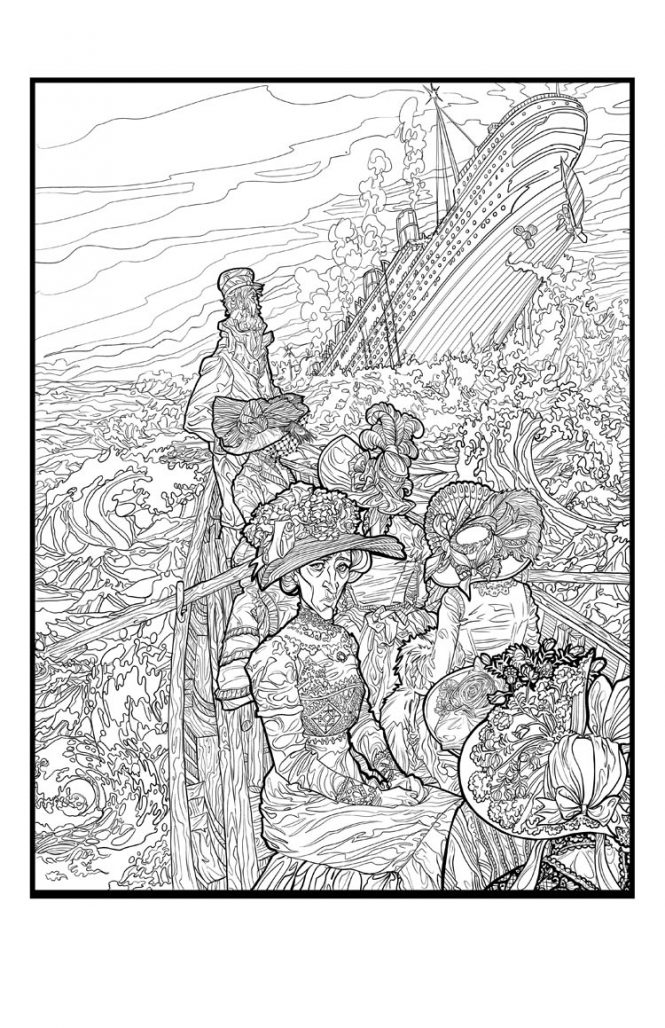
CB: We’ve had some exchanges now, it’s probably most shocking to me to find that in all the collaborations you’ve been part of, it seems like you’re the voice of reason and everyone is trying to out Chuck you. Bait, feels like it gave these artists that challenge. Let’s talk about the innocence of this coloring idea.
What is it about “the inner child” that entices us to color as grownups in this new wave of casual adult art?
Palahniuk: The New York Times ran an article last year in which a neuroscientist speculated that coloring provides the peaceful mind state of creating art without the anxiety of worrying whether or not the finished piece will be successful. It’s creativity minus most of the guesswork. It’s tactile and nonverbal. And it frees the creator to engage in conversation. Coloring groups have replaced book clubs as the place to talk and drink wine.
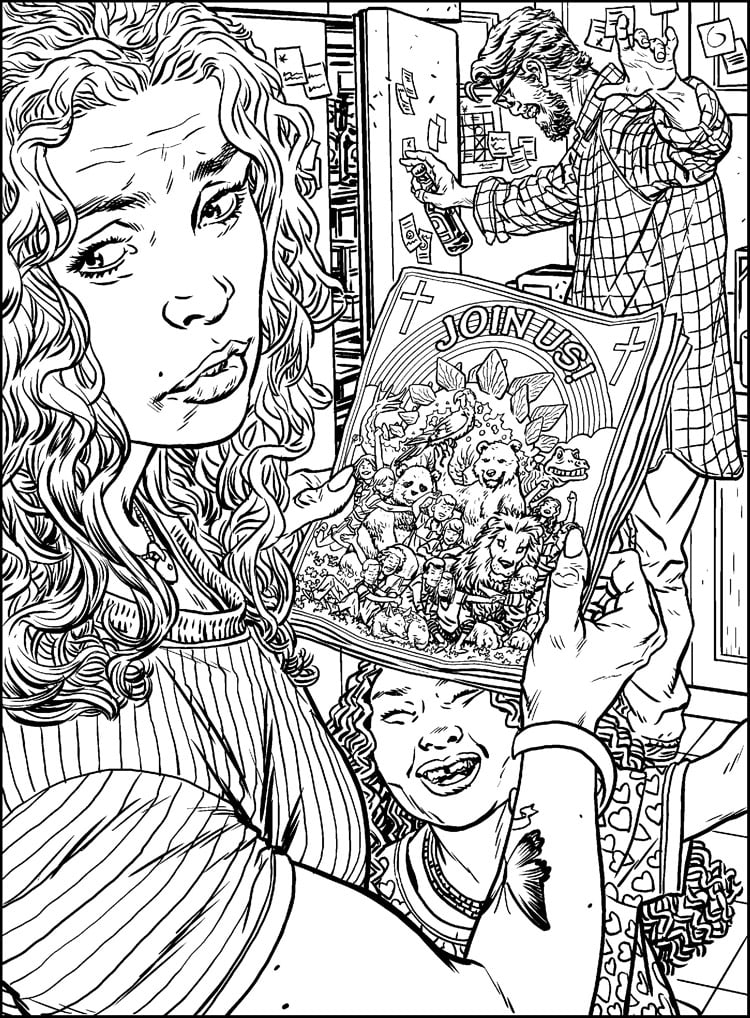
CB: You make it sound so damn cool. Along with the morbid humor and unorthodox romantic ideas fans love about your work, we all recognize the exquisite level of visceral detail in your stories. While the tales in Bait leave a bit more of that detail open to interpret, some of the stories have slivers of color written in. Is your intent for readers to go off script from the descriptive hues you’ve already laid out?
Palahniuk: Blame Scott Allie. Right away, he realized the story “Dad All Over” took place in a monochromatic world of snowdrifts. So we created “coloring opportunities” by describing the snow as a rainbow of specific hues. We asked for tattoos. We loved how Duncan Fegredo filled people’s skin with bandages and how Joelle Jones created a strong suggestion of stained glass in her work. Any fabrics depicted had to have a pattern. Even Kirbi Fagan’s skies had to fill up with stylized clouds.
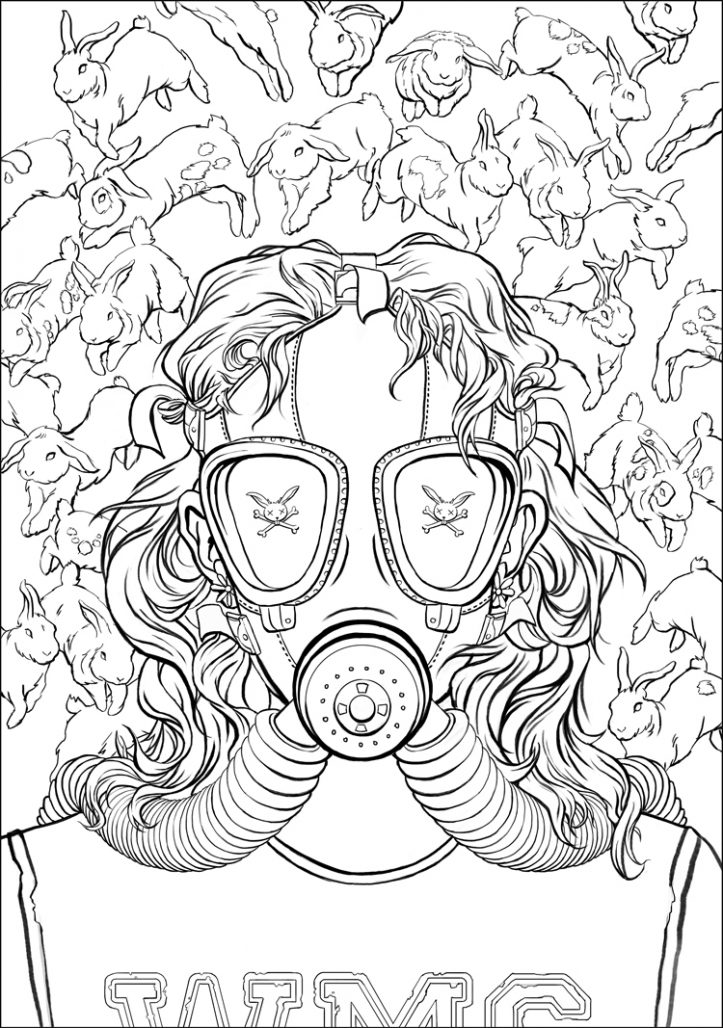
CB: That’s not something I paid particular attention to until I went back and read it again and looked at the drawings. You’re spot on, these artists have added so much minutia for coloring it adds a practical value on top of a gorgeous aesthetic.
Which of the stories in this book is most personal to you?
Palahniuk: My most/least favorite of the stories is “Dad All Over.” I cared for my mother during the final weeks of her lung cancer, before a stroke killed her in her sleep. At her funeral her best friend confided that it was fortunate she’d died suddenly, before having to take massive amounts of pain killers. This friend said my mother’s greatest fear had been that she might get so high she’d “tell her kids what she really thought of you.” I was stunned to think my mother held any secret hatred or resentments for her four children. Writing “Dad All Over” allowed me to explore the idea and create closure.
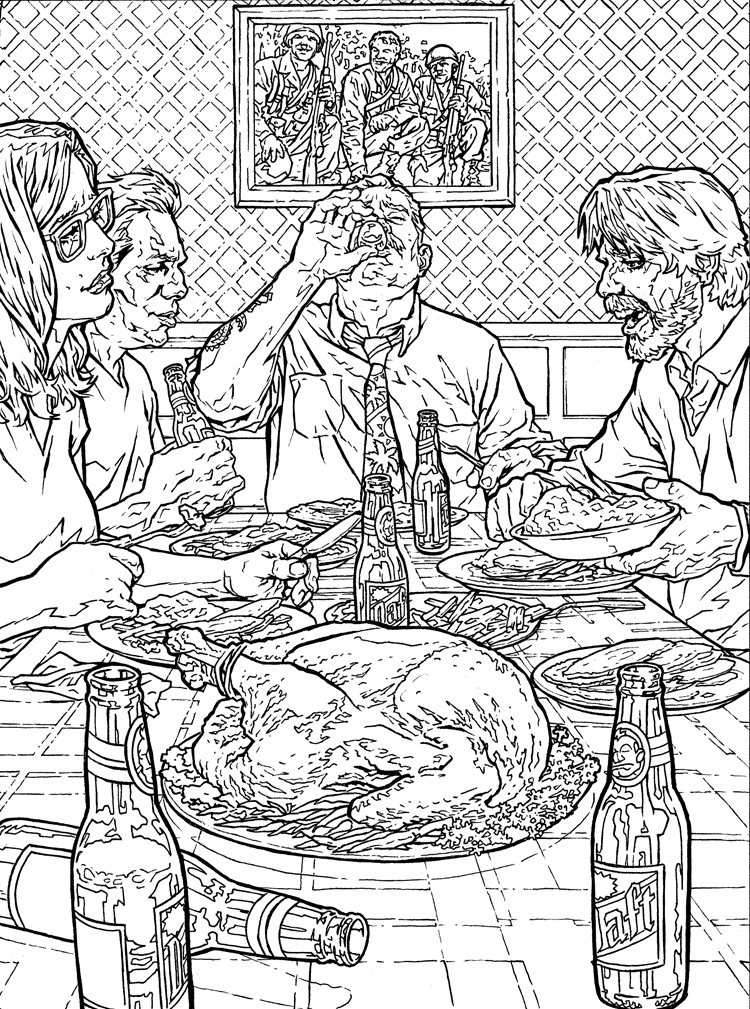
CB: Wow. I know I’m always in for something deep and shocking when I get to do these with you but that’s incredbly bold to be willing to take on those feelings head on.
Much of your early adult life was very blue collar. You’ve been an escort/transporter for the terminally ill at hospice and for a time a Freightliner mechanic. After already telling so many stories, I can’t imagine you today having those same hard labor experiences to draw ideas from. How do you still to find such raw and radical inspirations to write about things such as historically themed sex auctions or a guy’s self-preservation castration?
Palahniuk: The key is always consent. I’m fascinated by how structured mutual consent allows us to explore our relationships to power. Sexual race play is so popular because it allows people to assume and express the worst racial stereotypes and sexually exhaust the emotion that surrounds them. Likewise, any surgery is consensual, structured violence, just as Fight Club was. The first rule is always Consent.
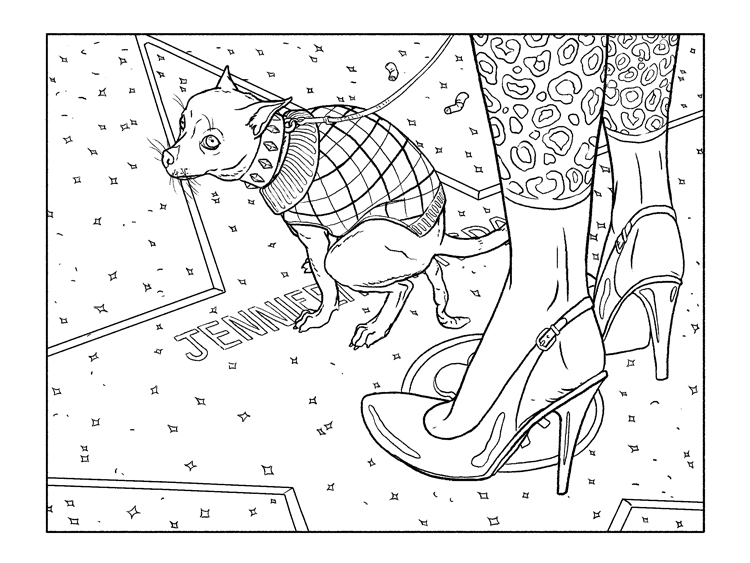
CB: In a way that seems actually the real first rule of Fight Club; be willing to give yourself to Fight Club. Then don’t talk about it.
Prose and comics seem like such different processes, yet here they blend together seamlessly. Bait, has a collection of incredible illustrators like Joelle Jones, Steve Morris, and Lee Bremejo just to name a few. Instead of sequentially drawing a narrative, these artists are doing very select images in each story. How does the collaborative process work on a book like this in terms of what kind of instruction or notes you gave the artists?
Palahniuk: As I wrote each story, I created a list of images that the artist could consider depicting. These included full-page and partial-page subjects, all lifted from the narrative. Scott Allie, the editor, added to each list and routed everything to the artist. The artist read the story and suggested alternative images that would work better, or suggested tweaks to the ideas we’d offered.
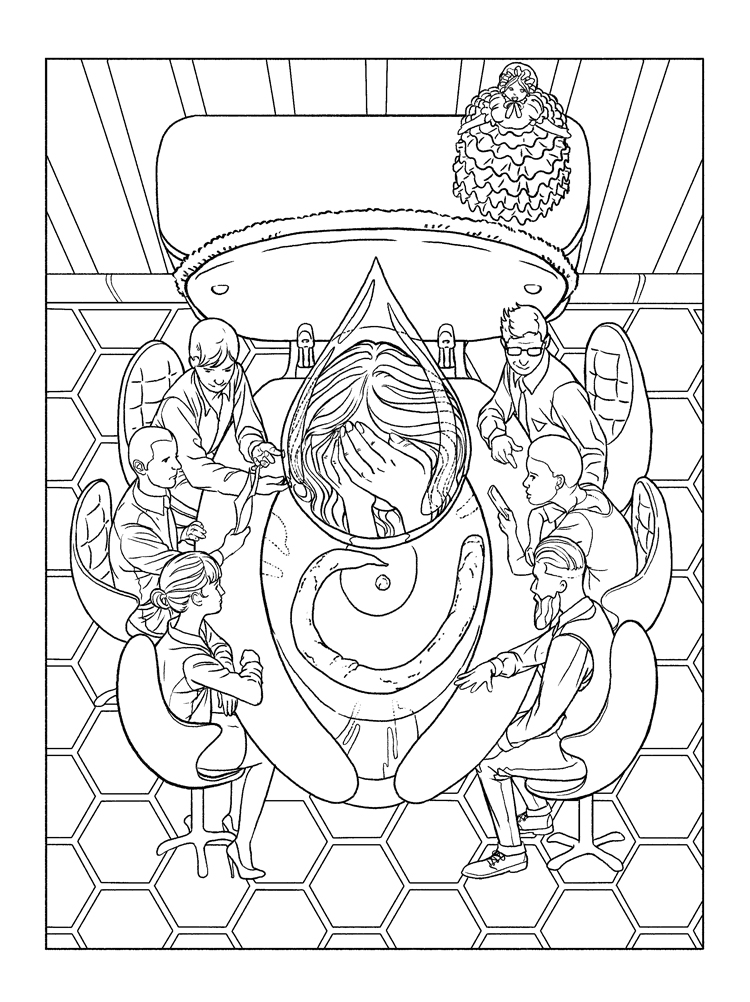
CB: I know you often run your stories by trusted opinions, but that’s a level of collaboration I didn’t anticipate for these. All the pitches make it seem like Bait was artists paid to draw what they were told, but in fact they have just as much influence over these narratives. Speaking of artists, I have to ask about THE artist.
Recently at SDCC, I had the pleasure of talking to David Mack about Kabuki. While we were on the subject of his part in Fight Club 2 he had a few enlightening things to say about the similarities you both share as storytellers. What is it about Mack as an artist that makes you gravitate toward his work, so much so that he contributes a rather flattering portrait of you for the author’s photo in Bait?
Palahniuk: David Mack is one of the very few creative people I’ve ever met who can articulate their artistic process. He’s aware of his intention with every detail, and he’s aware of the unresolved demons that power his work. Most artists and writers give vague, abstract explanations for why and how they create, while David can empirically unpack the reasoning behind his every line. Most people are used by their demons. David Mack has harnessed his.
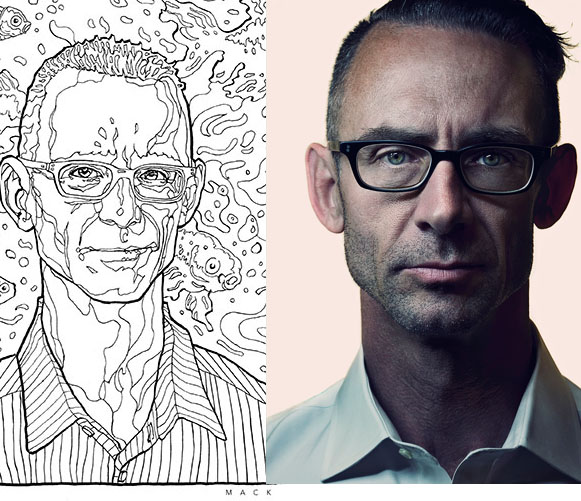
CB: Those demons including nude cat portraits from what I hear.
Finally, and this will only make sense if you read your introduction in the book so everyone reading this… go get it; did you ever get that stuffed octopus?
Palahniuk: Eventually I won a green stuffed octopus. It, like all my childhood plush toys, fell victim to my occasional bedwetting. No, this is not as winsome and romantic as the death of the Velveteen Rabbit, but I’d wager the vast majority of beloved stuffed animals fall victim to urine-related deaths. Perhaps there’s a story here for the next coloring book? Say, “The Calico Pony that Drowned in Pee” in a new volume, “More Off-Color Stories for You to Color.”
CB: Indeed! Ask Cameron Stewart to come back and draw a coming of age story from my childhood, “The Shakey’s Shark Swimming in S**T”.
While Chuck Palahniuk maps out a second coloring book for you; everyone can work on the first volume, Bait: Off-Color Stories for You to Color which is out now in your local comic book stores and bookstores everywhere.



